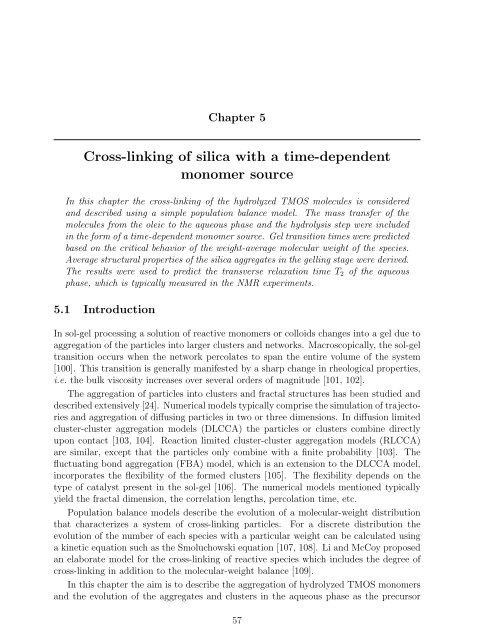Untitled - Technische Universiteit Eindhoven
Untitled - Technische Universiteit Eindhoven
Untitled - Technische Universiteit Eindhoven
- No tags were found...
You also want an ePaper? Increase the reach of your titles
YUMPU automatically turns print PDFs into web optimized ePapers that Google loves.
Chapter 5Cross-linking of silica with a time-dependentmonomer sourceIn this chapter the cross-linking of the hydrolyzed TMOS molecules is consideredand described using a simple population balance model. The mass transfer of themolecules from the oleic to the aqueous phase and the hydrolysis step were includedin the form of a time-dependent monomer source. Gel transition times were predictedbased on the critical behavior of the weight-average molecular weight of the species.Average structural properties of the silica aggregates in the gelling stage were derived.The results were used to predict the transverse relaxation time T 2 of the aqueousphase, which is typically measured in the NMR experiments.5.1 IntroductionIn sol-gel processing a solution of reactive monomers or colloids changes into a gel due toaggregation of the particles into larger clusters and networks. Macroscopically, the sol-geltransition occurs when the network percolates to span the entire volume of the system[100]. This transition is generally manifested by a sharp change in rheological properties,i.e. the bulk viscosity increases over several orders of magnitude [101, 102].The aggregation of particles into clusters and fractal structures has been studied anddescribed extensively [24]. Numerical models typically comprise the simulation of trajectoriesand aggregation of diffusing particles in two or three dimensions. In diffusion limitedcluster-cluster aggregation models (DLCCA) the particles or clusters combine directlyupon contact [103, 104]. Reaction limited cluster-cluster aggregation models (RLCCA)are similar, except that the particles only combine with a finite probability [103]. Thefluctuating bond aggregation (FBA) model, which is an extension to the DLCCA model,incorporates the flexibility of the formed clusters [105]. The flexibility depends on thetype of catalyst present in the sol-gel [106]. The numerical models mentioned typicallyyield the fractal dimension, the correlation lengths, percolation time, etc.Population balance models describe the evolution of a molecular-weight distributionthat characterizes a system of cross-linking particles. For a discrete distribution theevolution of the number of each species with a particular weight can be calculated usinga kinetic equation such as the Smoluchowski equation [107, 108]. Li and McCoy proposedan elaborate model for the cross-linking of reactive species which includes the degree ofcross-linking in addition to the molecular-weight balance [109].In this chapter the aim is to describe the aggregation of hydrolyzed TMOS monomersand the evolution of the aggregates and clusters in the aqueous phase as the precursor57
















